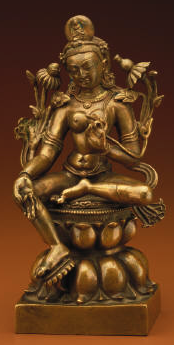
11th century, Kashmir artist in Western Tibet, (Vajra)mala, brass with cold gold and pigments, photo and details in an article by Yannick Laurent , Lima Lakhang, Lhasa (Tibet).
We saw a sculpture of Vajradhvaja (see above link) in a similar style -including the sacred cord worn on the left side of the torso and not visible on the other side. However, in this case both knees touch the base, there is no silver or copper inlay, and the decoration on the garment is different. Vajramala is one of the offering goddesses in the Vajradhatu mandala. She holds a garland (missing here) in both hands.

10th century, India (Kashmir), Arya Janguli, brass, private collection, photo by Rossi & Rossi .
Janguli in her three-head (each with three silver-inlaid eyes) and six-arm form, holding an arrow and a bow in her upper hands, a vajra sceptre and a large flower in her middle hands. The main right hand is in the gesture of reassurance, the left one makes a threatening gesture usually associated with a noose (tarjani mudra). She sits, with her legs unlocked, on a lotus atop a throne supported by garudas. There is a snake, her main attribute, on each side of the seat.

10th or 11th century, Kashmir, Janguli, brass with cold gold and blue pigment, photo after Ulrich von Schroeder in a book by Miranda Shaw and on Tsemrinpoche , at the Lima Lakhang in the Potala (Tibet).
A similar depiction, with the main lower hand in the gesture of supreme generosity.

Circa 8th-9th century, Kashmir, Tara, copper alloy with silver and copper inlay, according to David Weldon , 10th century, Chamba, according to P. Pal in the Journal of the Royal Society of Arts October 1973, p. 7744, Fig. 14.
This four-arm form of Tara appears to be holding a hook and a sheathed lasso in her upper hands. She has the stem of a lotus in the lower left one and her right hand makes the gesture of supreme generosity. At her feet, a female figure holds a garland in her left hand.














